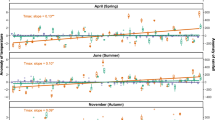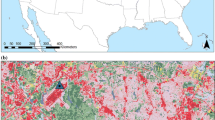Abstract
Understanding the causes of interannual variability in atmospheric pollen concentration is an important but elusive goal for public health and environmental change. We analyzed long-term daily records of pollen counts from urban Kansas City, Missouri, USA collected from 1997 to 2009 for three pollen groups: Ambrosia, Poaceae, and a third group which is mostly composed of arboreal pollen types. The annual pollen index varied from 8,368 to 80,822 over the thirteen-year period. Although Ambrosia pollen is often thought to be associated with droughts and disturbance, years with high Ambrosia pollen were associated with high summer precipitation to the south of Kansas City. Years with high Poaceae pollen were associated with high spring precipitation to the south of the city. In support of the southern influence to Kansas City pollen, Ambrosia and Poaceae pollen mostly arrived on southern winds. In contrast to the other two pollen groups, the arboreal pollen was most associated with growing season precipitation to the east of Kansas City, although it was still highest on days with southern winds. Based on the correlations with climate, the severity of an upcoming allergy season may be predicted with early-season precipitation data, while short-term severity can be forecast from local weather patterns.




Similar content being viewed by others
References
Barnes, C., Pacheco, F., Landuyt, J., Hu, F., & Portnoy, J. (2001). The effect of temperature, relative humidity and rainfall on airborne ragweed pollen concentrations. Aerobiologia, 17, 61–68.
Cecchi, L., Malaspina, T. T., Albertini, R., Zanca, M., Ridolo, E., Usberti, I., et al. (2007). The contribution of long-distance transport to the presence of Ambrosia pollen in central northern Italy. Aerobiologia, 23(2), 145–151. doi:10.1007/s10453-007-9060-4.
Chamecki, M., Meneveau, C., & Parlange, M. B. (2009). Large eddy simulation of pollen transport in the atmospheric boundary layer. Journal of Aerosol Science, 40(3), 241–255. doi:10.1016/j.jaerosci.2008.11.004.
Craine, J. M., Towne, E. G., Joern, A., & Hamilton, R. G. (2009). Consequences of climate variability for the performance of bison in tallgrass prairie. Global Change Biology, 15(3), 772–779. doi:10.1111/j.1365-2486.2008.01769.x.
Edmonds, R. L. (1979). Aerobiology: The ecological systems approach. Stroundsburg, Pennsylvania: Academic Press.
Garcia-Mozo, H., Perez-Badia, R., Fernandez-Gonzalez, F., & Galan, C. (2006). Airborne pollen sampling in Toledo, central Spain. Aerobiologia, 22(1), 55–66. doi:10.1007/s10453-005-9015-6.
Kinney, P. L. (2008). Climate change, air quality, and human health. American Journal of Preventive Medicine, 35(5), 459–467. doi:10.1016/j.amepre.2008.08.025.
Knapp, A. K., Briggs, J. M., & Koelliker, J. K. (2001). Frequency and extent of water limitation to primary production in a mesic temperate grassland. Ecosystems, 4(1), 19–28.
Mahura, A. G., Korsholm, U. S., Baklanov, A. A., & Rasmussen, A. (2007). Elevated birch pollen episodes in Denmark: Contributions from remote sources. Aerobiologia, 23(3), 171–179. doi:10.1007/s10453-007-9061-3.
Mao, Y. Y., & Huang, S. Q. (2009). Pollen resistance to water in 80 angiosperm species: Flower structures protect rain-susceptible pollen. New Phytologist, 183(3), 892–899. doi:10.1111/j.1469-8137.2009.02925.x.
Martin, M. D., Chamecki, M., Brush, G. S., Meneveau, C., & Parlange, M. B. (2009). Pollen clumping and wind dispersal in an invasive angiosperm. American Journal of Botany, 96(9), 1703–1711. doi:10.3732/ajb.0800407.
Pashley, C. H., Fairs, A., Edwards, R. E., Bailey, J. P., Corden, J. M., & Wardlaw, A. J. (2009). Reproducibility between counts of airborne allergenic pollen from two cities in the East Midlands, UK. Aerobiologia, 25(4), 249–263. doi:10.1007/s10453-009-9130-x.
Pendell, G. G., Hu, F., Portnoy, J., & Barnes, C. (2007). Global climatic change and its impact on oak pollen season in the Midwestern US. Annals of Allergy, Asthma & Immunology, 98(1), A107–A107.
Pendell, G. G., Hu, F., Pacheco, F., Portnoy, J., & Barnes, C. (2008). Seasonal and daily patterns of Cupressaceae pollen in Kansas City. Journal of Allergy and Clinical Immunology, 121(2), 81.
Perez, C. F., Gassmann, M. I., & Covi, M. (2009). An evaluation of the airborne pollen-precipitation relationship with the superposed epoch method. Aerobiologia, 25(4), 313–320. doi:10.1007/s10453-009-9135-5.
Peternel, R., Culig, J., Hrga, I., & Hercog, P. (2006). Airborne ragweed (Ambrosia artemisiifolia L.) pollen concentrations in Croatia, 2002–2004. Aerobiologia, 22(3), 161–168. doi:10.1007/s10453-006-9028-9.
Portnoy, J., & Barnes, C. (2003). Clinical relevance of spore and pollen counts. Immunology and Allergy Clinics of North America, 23(3), 389–410. doi:10.1016/s0889-8561(03)00028-6.
Reese, C. A., & Liu, K. B. (2005). Interannual variability in pollen dispersal and deposition on the tropical Quelccaya Ice Cap. Professional Geographer, 57(2), 185–197.
Sikoparija, B., Radisic, P., Pejak, T., & Simic, S. (2006). Airborne grass and ragweed pollen in the southern Panonnian Valley—consideration of rural and urban environment. Annals of Agricultural and Environmental Medicine, 13(2), 263–266.
Smith, M., Skjoth, C. A., Myszkowska, D., Uruska, A., Puc, M., Stach, A., et al. (2008). Long-range transport of Ambrosia pollen to Poland. Agricultural and Forest Meteorology, 148(10), 1402–1411. doi:10.1016/j.agrformet.2008.04.005.
Smith, M., Emberlin, J., Stach, A., Rantio-Lehtimaki, A., Caulton, E., Thibaudon, M., et al. (2009). Influence of the North Atlantic oscillation on grass pollen counts in Europe. Aerobiologia, 25(4), 321–332. doi:10.1007/s10453-009-9136-4.
Stepalska, D., Szczepanek, K., & Myszkowska, D. (2002). Variation in Ambrosia pollen concentration in southern and central Poland in 1982–1999. Aerobiologia, 18(1), 13–22.
Stepalska, D., Myszkowska, D., Wolek, J., Piotrowicz, K., & Obtulowicz, K. (2008). The influence of meteorological factors on Ambrosia pollen loads in Cracow, Poland, 1995–2006. Grana, 47(4), 297–304. doi:10.1080/00173130802492849.
Sugita, S. (1994). Pollen representation of vegetation in quaternary sediments: Theory and method in patchy vegetation. Journal of Ecology, 82, 881–897.
Sugita, S. (2007). Theory of quantitative reconstruction of vegetation II: All you need is love. Holocene, 17(2), 243–257.
Towne, E. G. (2002). Vascular plants of Konza prairie biological station: An annotated checklist of species in a Kansas tallgrass prairie. Sida, 20, 269–294.
Weaver, J. E. (1968). Prairie plants and their environment: A 50 year study in the Midwest. Lincoln, Nebraska, USA: University of Nebraska Press.
Ziska, L. H., Epstein, P. R., & Schlesinger, W. H. (2009). Rising CO2, climate change, and public health: Exploring the links to plant biology. Environmental Health Perspectives, 117(2), 155–158. doi:10.1289/ehp.11501.
Acknowledgments
We thank Julie Commerford for providing cartographic assistance. Jay Portnoy, Julie Landuyt, Freddy Pachecho, Frank Hu, and Minati Dhar provided the original pollen data from Children’s Mercy Hospital. Mary Knapp provided data from three weather stations. Konza Prairie Biological Station provided weather data from Kansas. We appreciate helpful discussions with Doug Goodin and John Harrington Jr. This research was supported by grant BCS-0821959 from the National Science Foundation to K.K.M. The data collection has been supported at times by Marrion-Merril-Dow and the Kansas City Allergy Society and throughout its history by Children’s Mercy Hospital.
Author information
Authors and Affiliations
Corresponding author
Rights and permissions
About this article
Cite this article
McLauchlan, K.K., Barnes, C.S. & Craine, J.M. Interannual variability of pollen productivity and transport in mid-North America from 1997 to 2009. Aerobiologia 27, 181–189 (2011). https://doi.org/10.1007/s10453-010-9186-7
Received:
Accepted:
Published:
Issue Date:
DOI: https://doi.org/10.1007/s10453-010-9186-7




